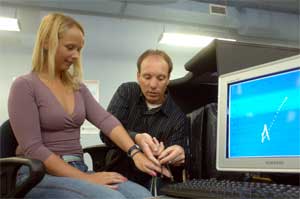 |
| David Westwood attaches sensors to student Krista Best's arm. The sensors record her movements, determining how fast and accurate she is. (Abriel photo) |
Imagine the day when someone paralyzed from the neck down can operate a computer using their eyes as a mouse. That day might could come more quickly than expected, according to David Westwood of pilipiliÂţ»'s School of Health and Human Performance.
Dr. WestwoodĂ•s work involves the science of movement control Ă‘ everything from measuring the pilipiliÂţ» of complex movements to whatĂ•s happening in the brain before our arms or eyes or legs begin to move.
His research has applications in many different areas, including space research, and rehabilitation, both of which could benefit from a better understanding of how motor learning occurs. One track of his research involves measuring eye movements. Using sophisticated software and a headpiece with two tiny cameras, he is trying to find out how the eye takes in visual information, and ultimately, how the brain uses this information to move the eyes to where they need to go.
Linkages
ÒItÕs a basic discovery question,” he says. ÒHow does the brain know how to move the eyes?
ÒIf the linkages between the brain and the eyes were better understood, that could have enormous implications for those with movement disorders, or spinal cord injuries.”
He also notes this research could have implications for understanding schizophrenia and autism, since abnormal eye movements can often be an early indicator for these disorders.
And then thereÕs the robot arm.
The Natural Sciences and Research Council of Canada (NSERC) has just awarded Dr. Westwood $17,187 for the purchase of a robot arm for research in human sensorimotor control. The arm acts as a kind-of two-way joystick. It attaches onto a subjectÕs arm and can be used to monitor their movements, but also perturb their limb to see how it responds. This tool will help him to better understand how the brain controls the arm when it adapts to new situations.
NSERC-funded research
Dr. Westwood is among the dozens of Dalhousie professors and students recently awarded $18 million in NSERC funding. The money from the federal funding agency will also fund 169 scholarships.
The investment represents 75 per cent of the total funding earmarked for eight institutions in Nova Scotia and 43 per cent of the total investment for the Atlantic region. Dalhousie ranked ninth nationally for science and engineering investment, ahead of larger schools such as McMaster and QueenÕs universities.
